Advanced Manufacturing Design of an Emergency Mechanical Ventilator via 3D Printing—Effective Crisis Response
Abstract
:1. Introduction
2. Materials and Methods
Initial Design
3. Results
3.1. Design Optimization
3.2. Manufacturing Process
3.3. Mass Production
4. Discussion
5. Conclusions
Author Contributions
Funding
Institutional Review Board Statement
Informed Consent Statement
Data Availability Statement
Conflicts of Interest
References
- Mostepaniuk, A.; Akalin, T.; Parish, M.R. Practices Pursuing the Sustainability of A Healthcare Organization: A Systematic Review. Sustainability 2023, 15, 2353. [Google Scholar] [CrossRef]
- Hatzilyberis, K.; Tsakanika, L.A.; Lymperopoulou, T.; Georgiou, P.; Kiskira, K.; Tsopelas, F.; Ochsenkühn, K.M.; Ochsenkühn-Petropoulou, M. Design of an advanced hydrometallurgy process for the intensified and optimized industrial recovery of scandium from bauxite residue. Chem. Eng. Process.-Process Intensif. 2020, 155, 108015–108033. [Google Scholar] [CrossRef]
- Kazakova, E.; Lee, J. Sustainable Manufacturing for a Circular Economy. Sustainability 2022, 14, 17010. [Google Scholar] [CrossRef]
- Naghshineh, B.; Carvalho, H. The implications of additive manufacturing technology adoption for supply chain resilience: A systematic search and review. Int. J. Prod. Econ. 2022, 247, 108387–108415. [Google Scholar] [CrossRef]
- Psomopoulos, C.S.; Kalkanis, K.; Kiskira, K.; Metaxa, S.; Kaminaris, D.; Ioannidis, G.; Chronis, I. A review of the environmental impacts following major recent catastrophic incidents in the energy industry. In Proceedings of the Seventh International Conference on Environmental Management, Engineering, Planning & Economics, Mykonos Island, Greece, 19–24 May 2019. [Google Scholar]
- World Health Organization (WHO). Critical Preparedness, Readiness and Response Actions for COVID-19: Interim Guidance, 7 March 2020. (No. WHO/COVID-19/Community_Actions/2020.1). Available online: https://apps.who.int/iris/bitstream/handle/10665/331422/WHO-COVID-19-Community_Actions-2020.1-eng.pdf?sequence=1&isAllowed=y (accessed on 15 January 2023).
- Fisher, D.; Heymann, D. Q&A: The novel coronavirus outbreak causing COVID-19. BMC Med. 2020, 18, 57–59. [Google Scholar] [PubMed]
- FDA. Enforcement Policy for Ventilators and Accessories and Other Respiratory Devices During the Coronavirus Disease 2019 (COVID-19) Public Health Emergency. Available online: https://www.fda.gov/regulatory-information/search-fda-guidance-documents/enforcement-policy-ventilators-and-accessories-and-other-respiratory-devices-during-coronavirus (accessed on 18 October 2020).
- Gibson, P.G.; Qin, L.; Puah, S.H. COVID-19 acute respiratory distress syndrome (ARDS): Clinical features and differences from typical pre-COVID-19 ARDS. Med. J. Aust. 2020, 213, 54–56. [Google Scholar] [CrossRef] [PubMed]
- World Health Organization (WHO). Clinical Management of Severe Acute Respiratory Infection When Novel Coronavirus (2019-nCoV) Infection is Suspected: Interim Guidance. Available online: https://apps.who.int/iris/handle/10665/330893 (accessed on 28 January 2020).
- Arulkumaran, N.; Brealey, D.; Howell, D.; Singer, M. Use of non-invasive ventilation for patients with COVID-19: A cause for concern? The Lancet. Respir. Med. 2020, 8, 45. [Google Scholar] [CrossRef]
- Srinivasan, S.; Panigrahy, A.K. COVID-19 ARDS: Can Systemic Oxygenation Utilization Guide Oxygen Therapy? Indian J. Crit. Care Med. Off. Publ. Indian Soc. Crit. Care Med. 2021, 25, 115–116. [Google Scholar]
- Ferguson, N.D.; Chiche, J.D.; Kacmarek, R.M.; Hallett, D.C.; Mehta, S.; Findlay, G.P.; Granton, J.T.; Slutsky, A.S.; Stewart, T.E. Combining high-frequency oscillatory ventilation and recruitment maneuvers in adults with early acute respiratory distress syndrome: The Treatment with Oscillation and an Open Lung Strategy (TOOLS) Trial pilot study. Crit. Care Med. 2005, 33, 479–486. [Google Scholar] [CrossRef]
- Camporota, L.; Sherry, T.; Smith, J.; Lei, K.; McLuckie, A.; Beale, R. Physiological predictors of survival during high-frequency oscillatory ventilation inadults with acute respiratory distress syndrome. Crit. Care 2013, 17, 1–10. [Google Scholar] [CrossRef] [PubMed]
- Luks, A.M. Ventilatory strategies and supportive care in acute respiratory distress syndrome. Influenza Other Respir. Viruses 2013, 7, 8–17. [Google Scholar] [CrossRef] [Green Version]
- Hess, D.R. Ventilator waveforms and the physiology of pressure support ventilation. Respir. Care 2005, 50, 166–186. [Google Scholar] [PubMed]
- Lian, J.X. Understanding ventilator waveforms—and how to use them in patient care. Nurs. Crit. Care 2009, 4, 43–55. [Google Scholar] [CrossRef]
- Donahoe, M. Basic ventilator management: Lung protective strategies. Surg. Clin. 2006, 86, 1389–1408. [Google Scholar] [CrossRef]
- Illinois Grainger College of Engineering, Illinois RapidVent: Working Prototype of an Emergency Ventilator for COVID-19 Patients. Available online: https://rapidvent.grainger.illinois.edu/ (accessed on 12 April 2020).
- King, W.P.; Amos, J.; Azer, M.; Baker, D.; Bashir, R.; Best, C.; Bethke, E.; Boppart, S.A.; Bralts, E.; Corey, R.M.; et al. Emergency ventilator for COVID-19. PLoS ONE 2020, 15, 0244963–0244982. [Google Scholar] [CrossRef] [PubMed]
- Attaran, M. The rise of 3-D printing: The advantages of additive manufacturing over traditional manufacturing. Bus. Horiz. 2017, 60, 677–688. [Google Scholar] [CrossRef]
- Gopal, M.; Lemu, H.G.; Gutema, E.M. Sustainable Additive Manufacturing and Environmental Implications: Literature Review. Sustainability 2023, 15, 504. [Google Scholar] [CrossRef]
- D’Haese, R.; Carpentier, O.; Dubois, V.; Chafei, S.; Wirquin, E. 3D-Printable Materials Made with Industrial By-products: Formulation, Fresh and Hardened Properties. Sustainability 2022, 14, 14236. [Google Scholar] [CrossRef]
- Advincula, R.C.; Dizon, J.R.C.; Chen, Q.; Niu, I.; Chung, J.; Kilpatrick, L.; Newman, R. Additive manufacturing for COVID-19: Devices, materials, prospects, and challenges. Mrs Commun. 2020, 10, 413–427. [Google Scholar] [CrossRef]
- Peron, M.; Sgarbossa, F.; Ivanov, D.; Dolgui, A. Impact of Additive Manufacturing on Supply Chain Resilience During COVID-19 Pandemic. In Supply Network Dynamics and Control, 1st ed.; Dolgui, A., Ivanov, D., Sokolov, B., Eds.; Springer International Publishing: Cham, Switzerland, 2022; Volume 20, pp. 121–146. [Google Scholar]
- Tareq, M.S.; Rahman, T.; Hossain, M.; Dorrington, P. Additive manufacturing and the COVID-19 challenges: An in-depth study. J. Manuf. Syst. 2021, 60, 787–798. [Google Scholar] [CrossRef]
- Cantini, A.; Peron, M.; De Carlo, F.; Sgarbossa, F. A decision support system for configuring spare parts supply chains considering different manufacturing technologies. Int. J. Prod. Res. 2022, 1–21. [Google Scholar] [CrossRef]
- Ranney, M.L.; Griffeth, V.; Jha, A.K. Critical supply shortages—the need for ventilators and personal protective equipment during the COVID-19 pandemic. N. Engl. J. Med. 2020, 382, 41–43. [Google Scholar] [CrossRef] [PubMed]
- Zuniga, J.M.; Cortes, A. The role of additive manufacturing and antimicrobial polymers in the COVID-19 pandemic. Expert Rev. Med. Devices 2020, 17, 477–481. [Google Scholar] [CrossRef] [PubMed]
- Volkswagen. From Making Cars to Ventilators. Available online: https://www.volkswagenag.com/en/news/stories/2020/04/from-making-cars-to-ventilators.html# (accessed on 15 June 2021).
- Ferrari. Ferrari Continues Its Efforts to Fight the COVID-19 Pandemic. Available online: https://www.ferrari.com/en-EN/corporate/articles/ferrari-continues-its-efforts-to-fight-the-covid-19-pandemic-corp (accessed on 10 January 2022).
- Airwolf3D. AIRWOLF3D Offering Emergency Additive Manufacturing Services. Available online: https://airwolf3d.com/2020/03/17/airwolf3d-offering-emergency-additive-manufacturing-services/ (accessed on 10 January 2021).
- Isinnova. Easy COVID. Available online: https://isinnova.it/archivio-progetti/easy-covid-19/ (accessed on 5 February 2021).
- Weerg. 3D Prints Valves for Emergency Respiratory Masks. Available online: https://www.digitalengineering247.com/article/weerg-3d-prints-valves-for-emergency-respiratory-masks (accessed on 10 December 2021).
- CRP Technology. CRP Technology on the Front Line in the Fight Against COVID-19. Available online: https://www.crptechnology.com/front-line-fight-against-covid19-mask-3d-printing/ (accessed on 30 September 2021).
- Roboze. COVID-19, The Value of Collaboration and Sharing. Available online: https://www.roboze.com/en/news/covid-19-the-value-of-collaboration-and-sharing.html (accessed on 10 July 2022).
- Neyman, G.; Irvin, C.B. A single ventilator for multiple simulated patients to meet disaster surge. Acad. Emerg. Med. 2006, 13, 1246–1255. [Google Scholar] [CrossRef]
- Ventsplitter. A Free 3D Printable Ventilator Circuit. Available online: https://ventsplitter.org/ (accessed on 5 May 2021).
- Illinois Grainger College of Engineering Illinois RapidVent Being Produced By Belkin Categories: Research Park, Recognition & Awards. Available online: https://researchpark.illinois.edu/article/illinois-rapidvent-belkin/ (accessed on 18 June 2020).
- Boros, R.; Rajamani, P.K.; Kovács, J.G. Combination of 3D printing and injection molding: Overmolding and overprinting. Express Polym. Lett. 2019, 13, 889–897. [Google Scholar] [CrossRef]
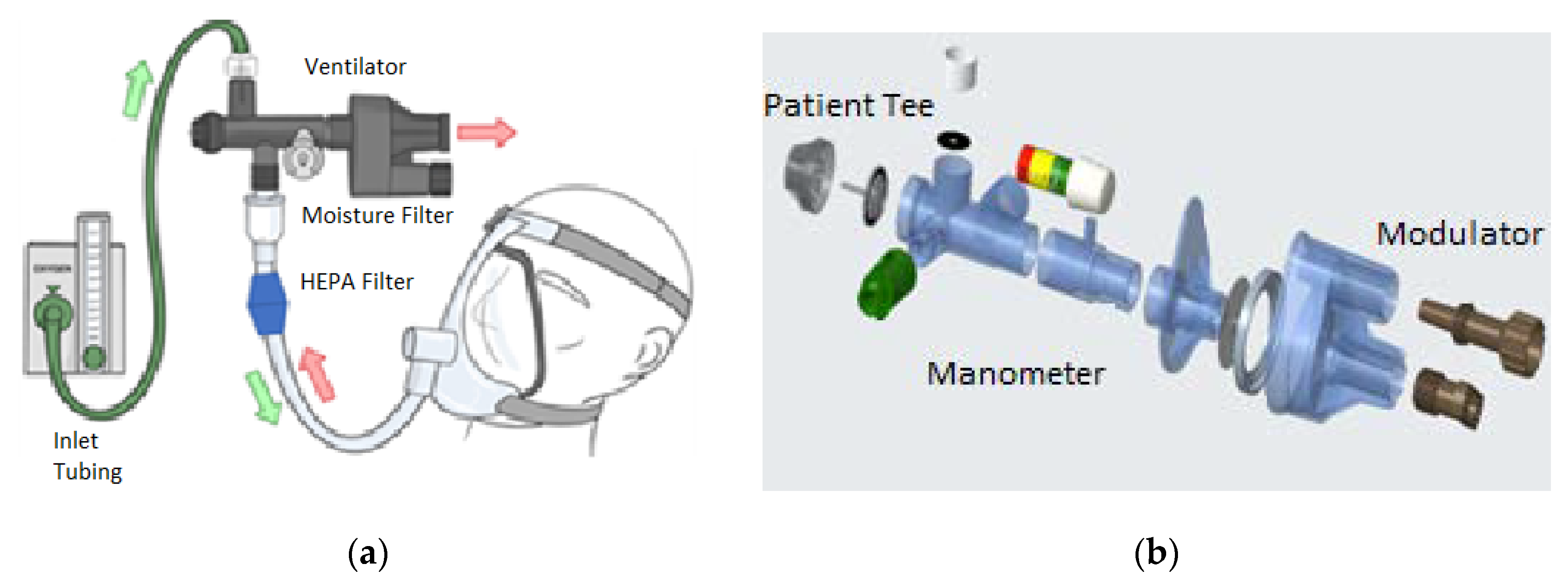
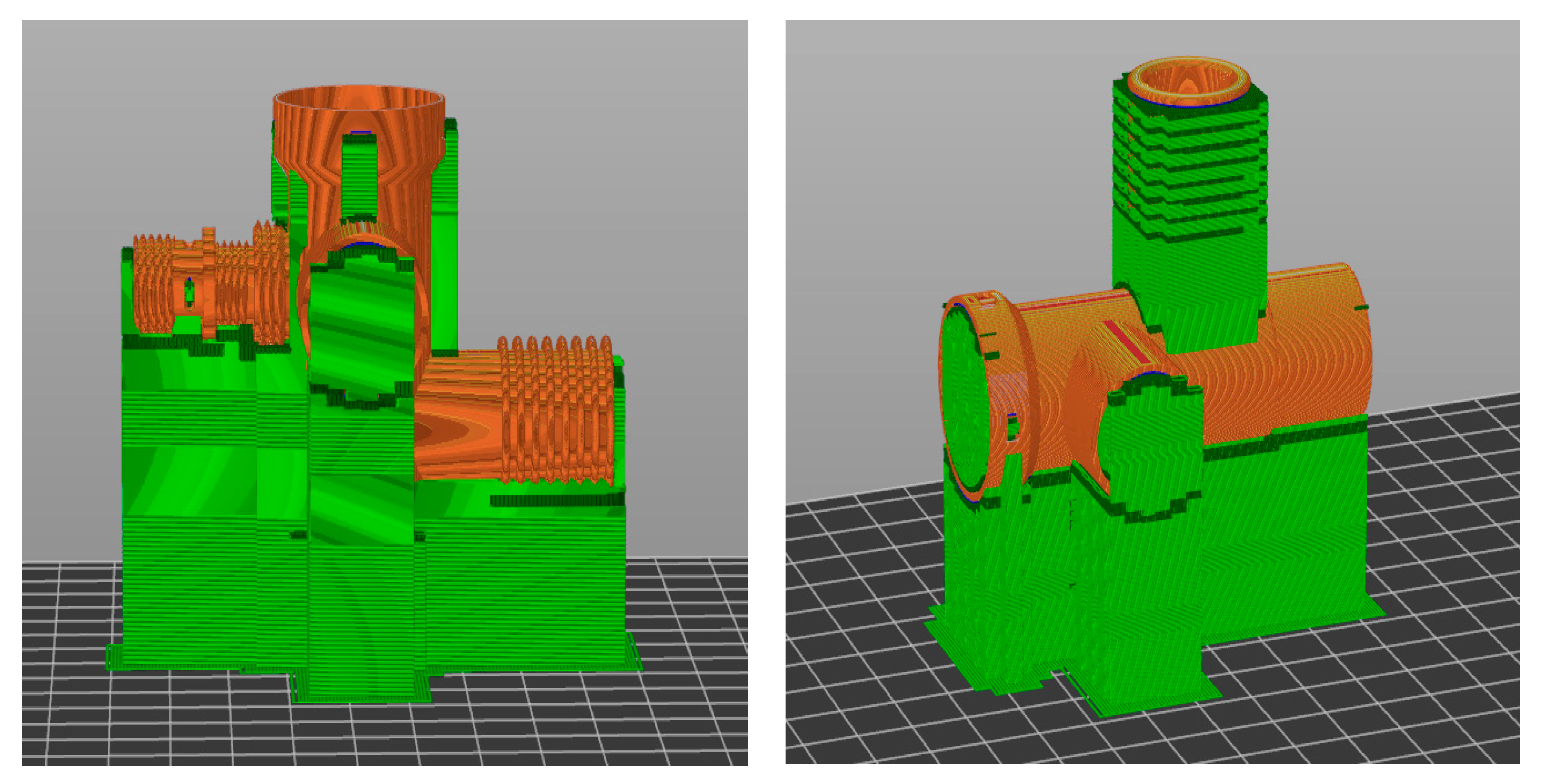


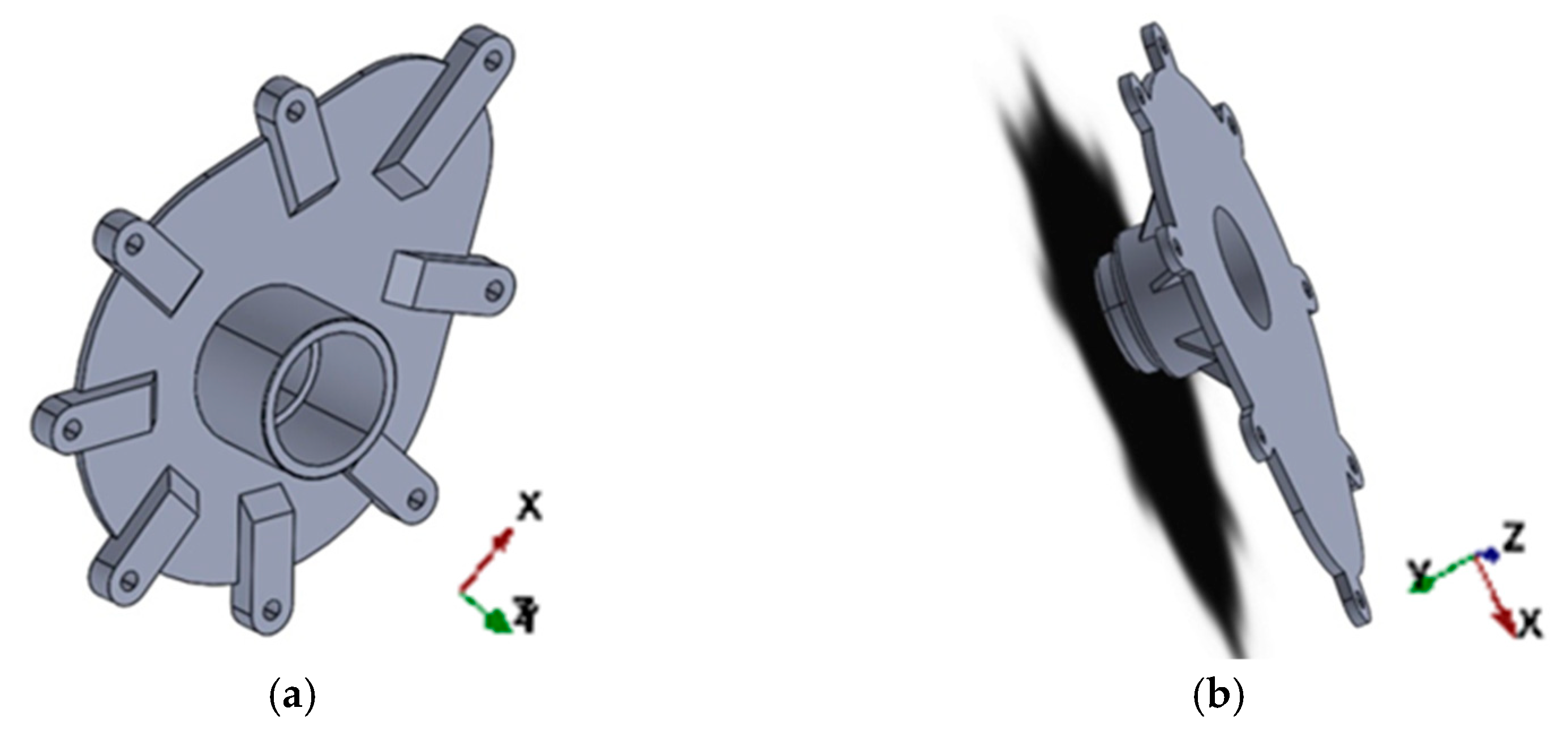


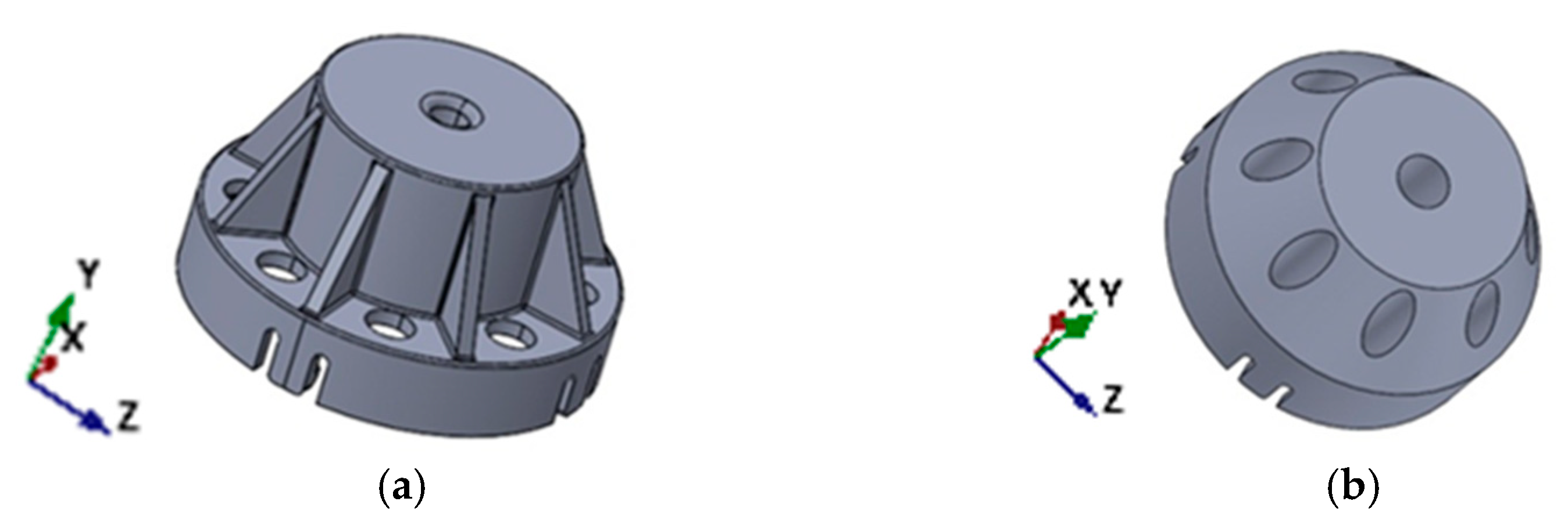

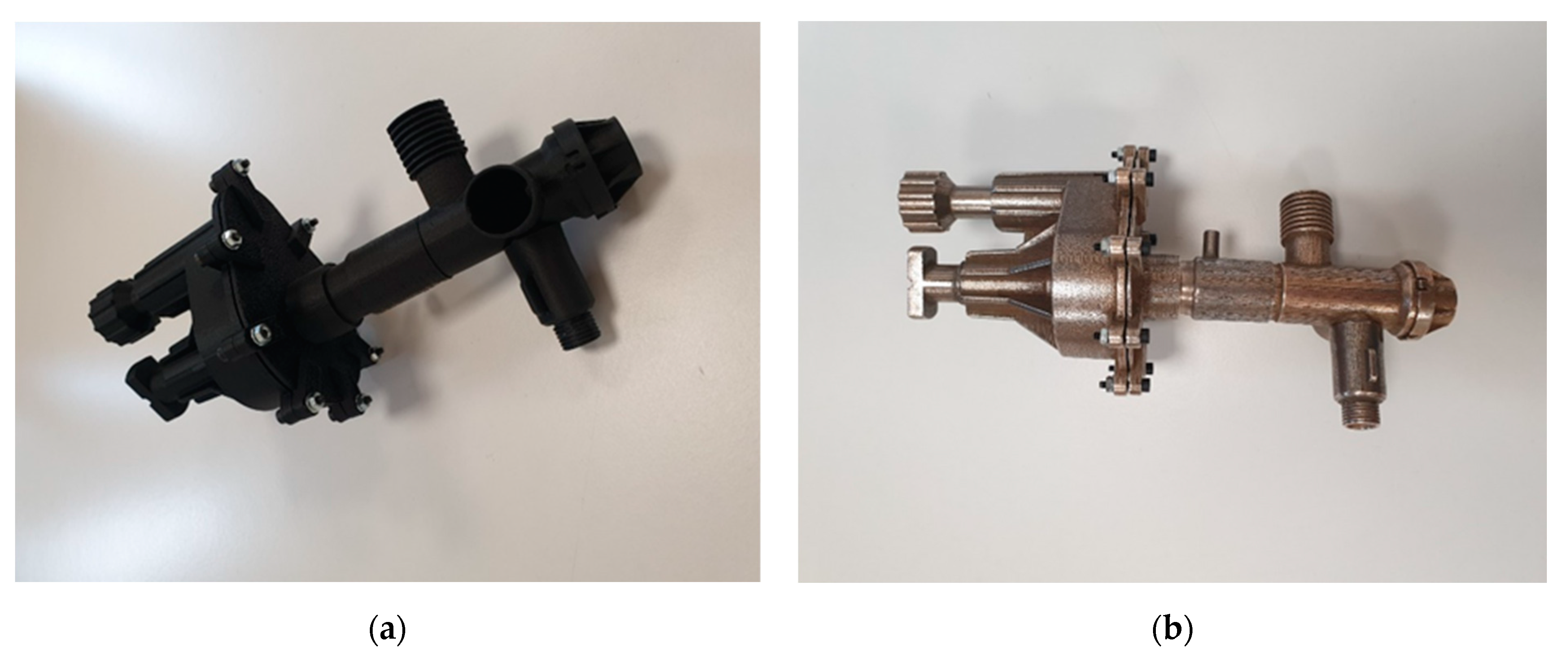
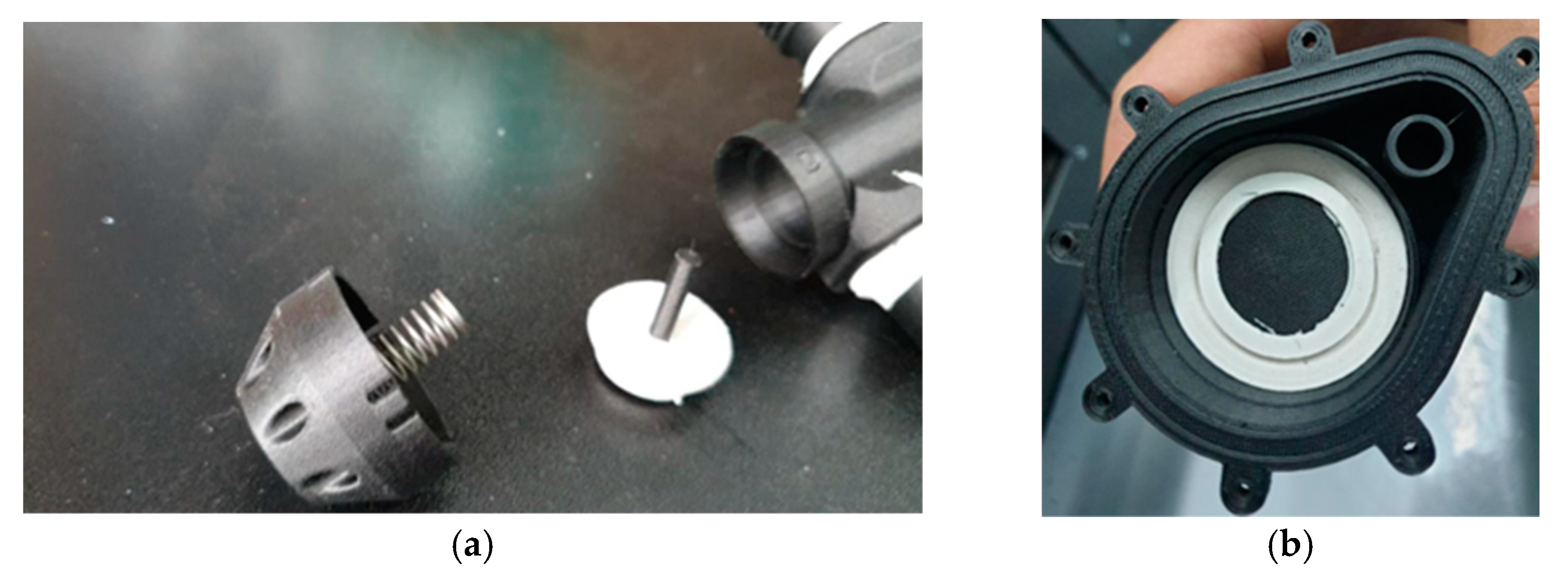

| 3D Printing | Injection Molding | |||
|---|---|---|---|---|
| Material | Cost/Part | Production Time/Part | Cost/Part | Production Time/Part |
| NYLON | EUR 200 | 1 working week | EUR 20 | 2 h |
| Steel | EUR 700 | 2 working weeks | EUR 100 | 4 h |
Disclaimer/Publisher’s Note: The statements, opinions and data contained in all publications are solely those of the individual author(s) and contributor(s) and not of MDPI and/or the editor(s). MDPI and/or the editor(s) disclaim responsibility for any injury to people or property resulting from any ideas, methods, instructions or products referred to in the content. |
© 2023 by the authors. Licensee MDPI, Basel, Switzerland. This article is an open access article distributed under the terms and conditions of the Creative Commons Attribution (CC BY) license (https://creativecommons.org/licenses/by/4.0/).
Share and Cite
Kalkanis, K.; Kiskira, K.; Papageorgas, P.; Kaminaris, S.D.; Piromalis, D.; Banis, G.; Mpelesis, D.; Batagiannis, A. Advanced Manufacturing Design of an Emergency Mechanical Ventilator via 3D Printing—Effective Crisis Response. Sustainability 2023, 15, 2857. https://doi.org/10.3390/su15042857
Kalkanis K, Kiskira K, Papageorgas P, Kaminaris SD, Piromalis D, Banis G, Mpelesis D, Batagiannis A. Advanced Manufacturing Design of an Emergency Mechanical Ventilator via 3D Printing—Effective Crisis Response. Sustainability. 2023; 15(4):2857. https://doi.org/10.3390/su15042857
Chicago/Turabian StyleKalkanis, Konstantinos, Kyriaki Kiskira, Panagiotis Papageorgas, Stavros D. Kaminaris, Dimitrios Piromalis, George Banis, Dimitrios Mpelesis, and Athanasios Batagiannis. 2023. "Advanced Manufacturing Design of an Emergency Mechanical Ventilator via 3D Printing—Effective Crisis Response" Sustainability 15, no. 4: 2857. https://doi.org/10.3390/su15042857






